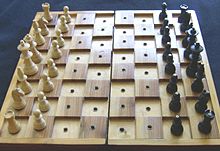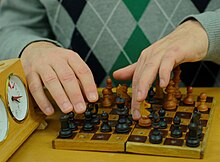Blind chess
Chess is called blind chess if at least one of the players is blind or visually impaired (then also visually impaired chess ). Blind chess should not be confused with blind chess (playing chess in your head without looking at the board) or chess blindness (overlooking very simple ways to play during a game).
Blind chess
The blind players use special plug-in chess games in order to be able to feel the pieces without them slipping or falling over. So that the blind player can distinguish the white from the black pieces, the black pieces are provided with balls or nails attached. The white and black fields on the board can be felt through slightly different heights. This pegboard was developed in 1848 at a school for the blind in London.
In addition to playing with each other, it also enables the blind to take part in tournaments with sighted people. The official rules of the World Chess Federation ( FIDE ) for tournament chess and the so-called two-board rule with stipulations for games between blind and sighted players apply. The blind man announces the moves he has made aloud and executes them on his game of pin chess; the sighted has a normal chess board in front of him and transfers the announced move to this board. The sighted person must also announce the moves he has made. According to the FIDE rules, a piece in blind chess is considered touched when the blind player takes the stone out of the hole. Then he has to move with this stone according to the touched-guided rule.
For the blind there are special chess clocks without glass, whose hands and dials can be felt. Since the fishing mode has become more and more popular in leagues and competitions , the blind also need digital chess clocks. Outwardly, these do not differ very much from ordinary digital chess clocks, but they have earphones and a voice output that announces the remaining time to think about and the number of moves to the visually impaired player.
In 1924, a chess notation in Braille was developed to record games, the so-called Marburg chess script .
Chess is one of the few sporting activities that sighted and blind people can practice under almost the same conditions.
The first chess club for the blind was founded in Chemnitz in February 1924 . Since 1958, when the International Braille Chess Association (IBCA) was founded, chess for the blind has also been organized internationally. In addition to national championships, world and European championships are also organized for the blind. Since 1994 a selection of the IBCA has taken part in the Chess Olympiad . In 1998 she achieved her best result to date with 52nd place.

For a long time Dieter Riegler was considered to be the strongest German visually impaired player. The German Blind and Visually Impaired Chess Federation (DBSB) also sent him regularly to the general German chess championship, where he achieved remarkable results. Internationally, the Yugoslav Dragoljub Baretic was considered one of the strongest blind players in the world. He took part in the 1962 B tournament in Hastings . One of the most successful blind players is the Russian Sergey Krylov ( Elo rating 2393, as of April 2007), who won the world title three times (1978, 1982 and 2004).
See also
Web links
- Official website of the German Chess Federation for the Blind and Visually Impaired
- Official website of the Austrian Blind Chess Federation ( Memento from July 20, 2015 in the Internet Archive )
- Official website of the Swiss Blind Chess Federation
- Hans-Gerd Schäfer: The History of the International Braille Chess Association
- FIDE rules for blind chess (English)
- International Association for Blind and Visually Impaired Chess Players ( Memento from October 23, 2008 in the Internet Archive )
- An instructive video on the subject of chess for the blind on Mittelbadische-Presse.TV by Melvin Raschke.
literature
- Harry Schaack: Bayern Munich for blind chess. Germany's most successful blind chess player Dieter Bischoff. In: KARL. The cultural chess magazine, 2, 2005, pp. 32–36. Karl-Verlag, Frankfurt ISSN 1438-9673 .
- Michael Negele: In the realm of the blind , magazine Schach 2014/4 pp. 48–55.


